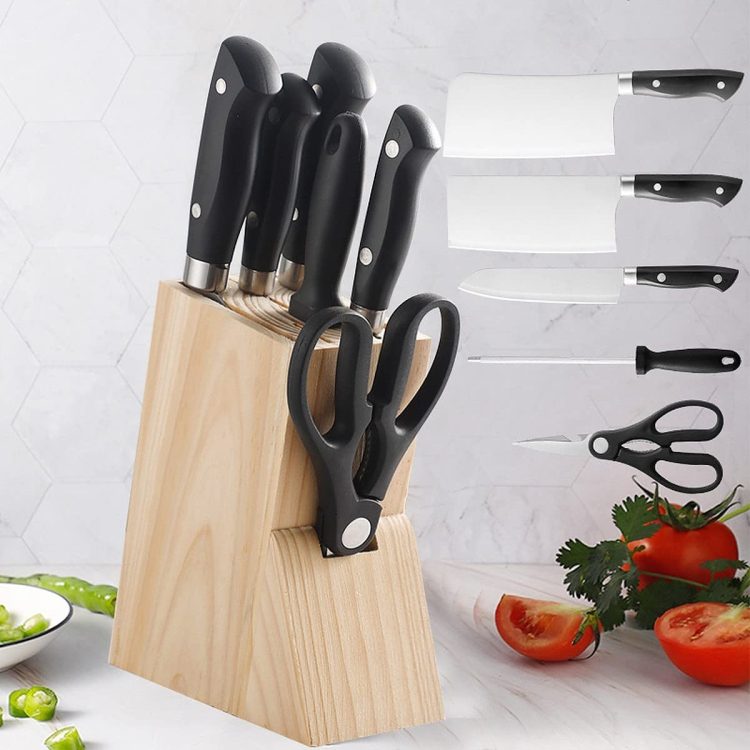When it comes to equipping your kitchen with essential tools, a good knife set is a top priority. A quality knife block set can make a significant difference in your cooking experience, as it provides you with a variety of knives designed for specific tasks. With so many options available, choosing the right knife block set can be a daunting task. In this guide, we will walk you through the essential factors to consider when selecting the perfect knife block set for your kitchen.
Table of Contents
1. Assess Your Cooking Needs
Before you start shopping for a knife block set, it’s crucial to assess your cooking needs and habits. Consider the types of dishes you frequently prepare and the techniques you use. Are you an avid home cook who enjoys experimenting with different cuisines, or do you mostly stick to basic cooking tasks? Understanding your cooking style will help you determine the types of knives you need in your set.
For those who love to explore various cooking techniques, a comprehensive set with a wide range of knife types may be the best choice. On the other hand, if you’re a minimalist cook who only needs the basics, a smaller set with fewer knives might be more practical.
2. Knife Types and Blade Materials
Knife block sets typically include various knife types, each designed for specific tasks. Here are some common types of knives you should look for in a set:
Chef’s Knife
The chef’s knife is a versatile, all-purpose knife that can handle a wide range of cutting tasks. Look for a set that includes a chef’s knife with a blade length of around 8 to 10 inches.
Paring Knife
A paring knife is a small, handy tool for precise tasks like peeling, trimming, and intricate cutting. Ensure your set includes a paring knife with a blade length of 3 to 4 inches.
Bread Knife
A bread knife features a serrated edge that makes slicing through bread and delicate pastries effortless. A blade length of 8 to 10 inches is ideal for most bread-cutting needs.
Utility Knife
A utility knife is a mid-sized knife that bridges the gap between a chef’s knife and a paring knife. It’s perfect for tasks like slicing sandwiches and small fruits or vegetables.
Steak Knives
Many knife block sets include steak knives for enjoying your favorite cuts of meat. Ensure the set includes enough steak knives for your household.
When it comes to blade materials, there are two primary options: stainless steel and high-carbon stainless steel. Stainless steel blades are known for their durability and resistance to staining and rust. High-carbon stainless steel blades are a bit sharper and may hold their edge longer, but they require more maintenance to prevent rust.
3. Consider the Knife Block Material
The knife block itself is an essential part of the set. It not only provides a safe storage space for your knives but also adds to the aesthetics of your kitchen. Knife blocks are typically made from wood, plastic, or metal, and each material has its advantages.
Wooden Knife Blocks
Wooden knife blocks are a popular choice due to their timeless and elegant appearance. They come in various wood types, including oak, walnut, and bamboo. Wooden blocks are sturdy and can protect your knives from damage. However, they may require occasional cleaning and maintenance to prevent mold or mildew.
Plastic Knife Blocks
Plastic knife blocks are lightweight and easy to clean. They are also less susceptible to moisture-related issues. However, plastic blocks may not offer the same level of durability and aesthetic appeal as wooden or metal options.
Metal Knife Blocks
Metal knife blocks, often made of stainless steel, are sleek and modern in design. They are durable and easy to clean. Some metal blocks feature slots that are easy to clean and sanitize. However, they may not provide the same level of knife protection as wooden blocks.
Choose a knife block material that complements your kitchen’s style and meets your maintenance preferences.
4. Handle Design and Comfort
The handle design of your knives plays a significant role in your overall comfort and control while cooking. Knife handles come in various shapes and materials, and personal preference plays a significant role in choosing the right one.
Handle Shapes
Traditional: These handles have a classic shape with a curved, ergonomic design that fits comfortably in your hand.
Japanese: Japanese knife handles are often straight and require a pinch grip, which can be comfortable for precision tasks.
Hybrid: Some handles combine elements of both traditional and Japanese designs, providing a compromise between comfort and control.
Handle Materials
Wood: Wooden handles are aesthetically pleasing and can offer a warm, natural feel. However, they may require more care to prevent damage.
Plastic: Plastic handles are lightweight and easy to clean but may not provide the same level of grip as other materials.
Composite: Composite handles often combine materials like wood and plastic to offer a balance of aesthetics and durability.
When choosing a knife block set, consider holding the knives in your hand to assess the comfort and grip of the handles. Your comfort and confidence while using the knives are essential for safe and efficient food preparation.
5. Budget and Quality
Knife block sets are available at various price points, so it’s essential to establish a budget before you start shopping. Keep in mind that the quality of knives can vary significantly based on price. While it may be tempting to opt for a budget-friendly set, investing in a higher-quality set can pay off in the long run.
Quality knives are often forged from a single piece of steel, which provides better durability and balance. They are also more likely to maintain their sharpness over time. Cheaper sets may have knives with stamped blades, which are less durable and may require more frequent sharpening.
Remember that a high-quality knife block set can last for many years with proper care, making it a valuable long-term investment in your kitchen.
6. Maintenance and Sharpening
To keep your knives performing at their best, regular maintenance and sharpening are essential. Consider the ease of sharpening and maintenance when selecting a knife block set. Some sets come with sharpening tools or honing rods, which can be convenient for keeping your knives sharp.
Additionally, check if the knives are dishwasher-safe or if they require hand washing. Hand washing is typically recommended to prolong the life of your knives and prevent damage to the handles.
7. Warranty and Customer Support
Lastly, check the warranty and customer support offered by the manufacturer. A reputable knife block set should come with a warranty that covers defects in materials or workmanship. Good customer support can be invaluable if you ever encounter issues with your knives or knife block.
Summary
Choosing the right knife block set for your kitchen involves considering your cooking needs, knife types and materials, knife block material, handle design and comfort, budget, maintenance requirements, and warranty. By carefully assessing these factors, you can make an informed decision that will enhance your cooking experience and provide you with reliable tools for years to come. A well-chosen knife block set is not just an investment in your kitchen; it’s an investment in your culinary skills and enjoyment.
Contact Us Today!
Ready to elevate your culinary experience with the perfect knife block set? Look no further than Make It Personal Today! With a wide range of knife block sets to choose from, tailored to your specific needs and preferences, we’re here to help you find the ideal set that aligns with your cooking style and enhances your kitchen’s aesthetics. Don’t miss out on the opportunity to invest in your culinary skills and make your kitchen a true culinary haven. Reach out to us today and embark on a journey towards precision and excellence in your cooking endeavors!








